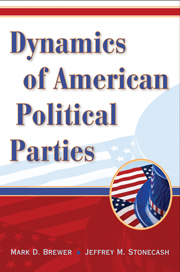Book contents
- Frontmatter
- Contents
- Figures and Tables
- Preface
- 1 DEMOCRACY, REPRESENTATION, AND PARTIES
- 2 OVERVIEW: SOCIAL CHANGE AND SHIFTING PARTY BASES
- 3 TAKING SHAPE: PARTY COALITIONS IN THE POST-BELLUM NINETEENTH CENTURY
- 4 REPUBLICAN ASCENDANCY AND DEMOCRATIC EFFORTS TO RESPOND, 1896–1928
- 5 TABLES TURN: THE NEW DEAL ERA AND DEMOCRATIC DOMINANCE, 1932–1948
- 6 THE DEMOCRATIC DRIVE TO THE GREAT SOCIETY
- 7 REPUBLICANS: REASSERTING CONSERVATIVE PRINCIPLES AND SEEKING A MAJORITY
- 8 THE STRUGGLE OF DEMOCRATS TO INTERPRET CHANGE AND RESPOND
- 9 GEORGE BUSH AND FURTHER POLARIZATION
- 10 THE 2008 ELECTION AND ITS INTERPRETATION
- 11 PARTIES AND THE PURSUIT OF MAJORITIES
- Bibliography
- Index
- References
7 - REPUBLICANS: REASSERTING CONSERVATIVE PRINCIPLES AND SEEKING A MAJORITY
Published online by Cambridge University Press: 05 June 2012
- Frontmatter
- Contents
- Figures and Tables
- Preface
- 1 DEMOCRACY, REPRESENTATION, AND PARTIES
- 2 OVERVIEW: SOCIAL CHANGE AND SHIFTING PARTY BASES
- 3 TAKING SHAPE: PARTY COALITIONS IN THE POST-BELLUM NINETEENTH CENTURY
- 4 REPUBLICAN ASCENDANCY AND DEMOCRATIC EFFORTS TO RESPOND, 1896–1928
- 5 TABLES TURN: THE NEW DEAL ERA AND DEMOCRATIC DOMINANCE, 1932–1948
- 6 THE DEMOCRATIC DRIVE TO THE GREAT SOCIETY
- 7 REPUBLICANS: REASSERTING CONSERVATIVE PRINCIPLES AND SEEKING A MAJORITY
- 8 THE STRUGGLE OF DEMOCRATS TO INTERPRET CHANGE AND RESPOND
- 9 GEORGE BUSH AND FURTHER POLARIZATION
- 10 THE 2008 ELECTION AND ITS INTERPRETATION
- 11 PARTIES AND THE PURSUIT OF MAJORITIES
- Bibliography
- Index
- References
Summary
The 1968 election shook the Democrats' confidence in their liberal policy agenda. It began a lengthy period of grappling with charges that the party had moved too far left in its efforts to advance an activist government agenda. For Republicans, the 1968 elections provided a vague sense, amid considerable political chaos, that a more conservative message could be presented to the public. However, it would take some time for that possibility to fully emerge. In reality, 1968 was just one of several fitful efforts by conservatives to push the GOP in a more conservative direction, efforts that moderates consistently opposed. The origins of conservative efforts began much earlier than the late 1960s and took a considerable amount of time to come to fruition.
The story of how conservatives made a comeback in American politics is a long one. It is a story of belief, persistence, organization, failure, and setback, overcoming doubts, making renewed efforts, and eventually realizing gains among voters that conservatives had to attract to achieve electoral success. It is a process in which conservatives were often dismissed and moderates argued that a conservative appeal would not work. It took weaving together a coalition that many doubted could be assembled. It is, moreover, a perfect example of the model of gradual realignment as a party searches for a majority.
- Type
- Chapter
- Information
- Dynamics of American Political Parties , pp. 104 - 144Publisher: Cambridge University PressPrint publication year: 2009



